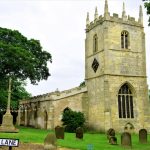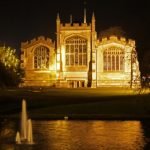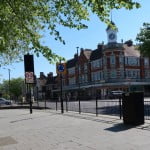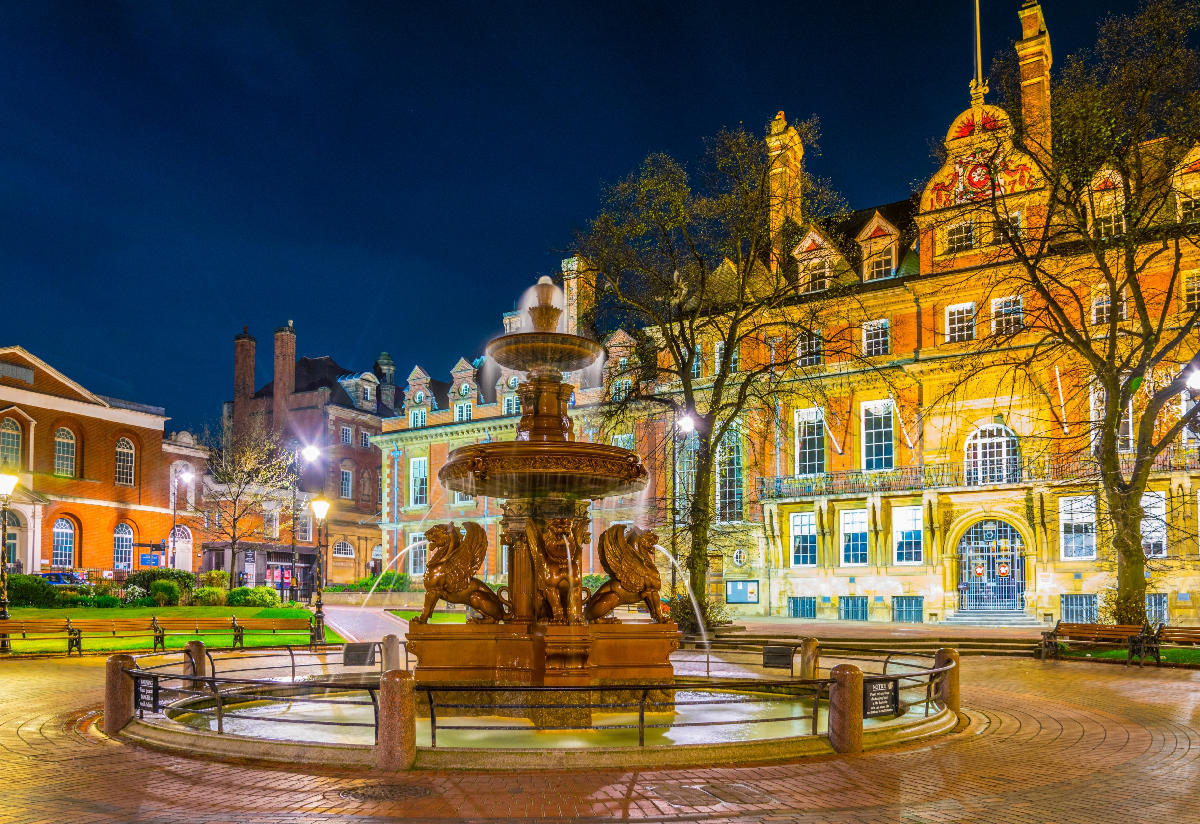
Your five-minute guide to Leicester!
Leicester, the only place in the world (outside of India, of course!) that holds the biggest celebration for the Festival of Lights. A city that held the body of King Richard III under its surface until he was finally discovered in 2012, and then reburied in the Cathedral. Famous for its lack of success in the FA Cup final, and home to the biggest covered outdoor market in Europe. there is a lot to like about the city so let’s delve into it starting with a bit of history…
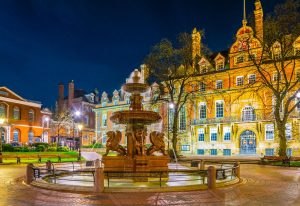
Image: trabantos/Shutterstock.com
History of Leicester
It was likely that Leicester started as a Celtic settlement. History shows that it was the capital of the local Celtic tribe, the Corieltauvi, at the beginning of its life. When the Romans invaded Britain in 43 CE, they ended up capturing Leicestershire just a few years later in 47 CE. The nearby Celtic settlement prospered as the Roman soldiers hosted a market for the town’s goods, and even when the Romans moved on, the area still lived incredibly well.
There were several temples in Roman Leicester. Roman Leicester reached a peak in the early 4th century then began to decline, and civilization broke down. It fell into ruins not long after the last of the soldiers left in the year 407.
Saxon Leicester
Saxon times were a little different. The town began to revive in the late 7th century, and it was given a bishop. By the 9th century, it seemed like everything was up and running again. However, Saxon Leicester was quite crude compared to the old Roman town that it once was. There were no fine stone buildings – just wood huts with thatched roofs. Potters, blacksmiths, and carpenters were the main career paths of men in the town.
Next the Danes invaded, capturing the city in 877. It was a fairly short rule lasting until 918, but it has a legacy today as several of the cities place names have Danish connotations.
The Doomsday Book
At the time of the Domesday Book, Leicester had a population of around 1,500. The Normans built a wooden castle in the late 11th century, and in the early 12th century, it was rebuilt in stone. Leicester was ruled by an Earl. However, the Earl appointed a steward to run the town’s day to day operations. The Earl caused a lot of suffering in 1173 when he rebelled against the king because the king’s men captured the town and burned part of it down.
The main industry in Medieval Leicester was wool. Weaving wool into cloth and dyeing it were both common practices at the time. Leather was also an important industry in Medieval Leicester and there were many tanners in the town. Like other English towns, there was also a weekly market and an annual fair. Leicester’s yearly fair would attract buyers and sellers from all over the Midlands.
Leicester Abbey was built in 1143, but Henry VIII closed it during his rule in the 16th century, alongside many other buildings that were providing needed services.
18th Century Leicester
Fast forward to the 18th century, and we see a rising population in Leicester. By 1800, there were 17,000 people living in the area. Pumps for water had been built by this time, the Royal Infirmary had been opened, and the New Walk had been constructed.
In the late 18th century, Leicester was transformed by the industrial revolution; as many towns and cities were at the time. The Soar Canal was completed in 1794 and it allowed the engineering industry of the area to start providing a cheap way of transporting coal and iron into Leicester.
Back to the early 19th century, we see the town continuing in its rapid growth. Houses are being built along many bare roads, connecting the entire town of Leicester together. In 1835, the boundaries of the town were extended to include the West Bank of the Soar. Amenities are improved in the 19th century, and Leicester gains gas street lighting, paved streets, a police force, and several new parks. The first public library opened in 1871, too!
Industrialisation
Engineering flourished, the shoemaking industry boomed, and a railway is erected, connecting Leicester to Swannington, and later to Rugby. Even later than that, Leicester is connected to London. These are lines that are still travelled today; though improvements have been made. The City continued to spread its boundaries into the surrounding countryside, and from the mid-19th century onwards, houses were built east of the town in the area that is now called Highfields.
Now a City
Leicester was made a city in 1919 and got its own was given a cathedral complete with bishop in 1927, and the boundaries of the city were once again extended in 1935. The University was established in 1957, and in 1969, Leicester Polytechnic was formed from the old College of Art and Technology – this became De Montfort University in 1992.
In 1971, the Haymarket Centre opened, followed by the Theatre in 1973. St. Martin’s Shopping Centre opened in 1984, the Phoenix Arts Centre in 1988, and the Shire Shopping Centre in 1992.
Today, Leicester is as large and as popular a location as ever. Let’s dive out of the history of the city, and into the fun to be had there.
What to do in Leicester
The City is home to one of the UK’s leading attractions is the National Space Centre. This amazing building holds over 150 interactive experiences, and is the UK’s largest planetarium. It’s recommended that you spend around three hours in this wonderous place, just because there’s so much to see and do that it isn’t a facility you can visit in a short amount of time. Great for children and adults who are fascinated by the universe!
But if space, for some reason, isn’t your thing, here are a bunch more activities and places to go in Leicester:
Shopping
If you’re going to go shopping in Leicester, there’s nowhere better to start your journey than Leicester city centre. This area is one of Leicester’s prime shopping locations, playing home to a range of major labels that you’ll recognise from any other big city.
Head over to High Street and find Highcross Leicester, Leicester’s premier shopping centre. It’s modern, it has approximately 100 stores, and you’ll be able to find everything from jewellery to games to homeware. But if you’d rather not go inside because it’s a beautiful day out, then you can certainly stick around on High Street for some imaginative gifts and treats.
Just off of High Street, you can discover the world of Leicester Lanes. A maze of narrow streets, not dissimilar to the kind you would find in Venice, holds a treasure chest of independent stores and eateries. More on the food venues of Leicester in the next section.
Food and Drink
The historic Silver Arcade is located on Silver Street. This building is four storeys high, and the building dates all the way back to the late 19th century. After it was refurbished in the modern era, Silver Arcade became one of the most well-known places in Leicester to get amazing and varied food and drink. There are coffee houses, tea rooms, and plenty of juice bars here, yes, but there are also excellent eateries and delis!
Speaking of tea rooms, head over to Loseby Lane and find Mrs Bridges Tea Rooms. This lovely establishment, originally built in 1723, still has the original cooking range in its cellar. Today, you can find great offers for afternoon tea, which includes homemade cakes and other sweet treats, as well as light savoury lunch items.
St. Martins Square holds the location of the wonderful Gelato Village; an award-winning gelato store which makes authentic gelato. This Italian gelato paradise makes all of its flavours with natural ingredients, and will serve them aside waffles or other pastries, should you wish to treat yourself on your visit.
And a quick mention goes to Kayal, one of the best-reviewed restaurants in Leicester. With almost 800 reviews on Google Reviews, averaging at 4.5 stars, this is a South Indian dining restaurant with a casual to semi-casual feel. The chefs serve beautiful dishes that come in large portions and are so well-presented, you’ll wonder why you’ve never visited before!
Music and Entertainment
Music is not sparse in Leicester. The Musician is an independent music venue tucked into the quieter back streets of the city. There is live music playing six nights a week, and the entire venue is accessible. Their reputation has been built on showcasing local performers who offer all kinds of music for folks to enjoy.
Similarly, there’s The Soundhouse on Southampton Street. This venue is known for its open mic nights, as well as the local performers that gather to spread their sound. Both The Soundhouse and The Musician are well-loved music venues in Leicester.
For any theatre and dance fans that have stumbled across this page, you’ll be happy to know that De Montfort Hall of Granville Road has a healthy programme of jazz, ballet, and opera performances; though they also book comedy performances and West End musicals, too.
Any Leicester visitors not looking for a musical place to go on their trip might enjoy any of the several parks scattered around the borders of Leicester, or even a trip to one of the historical sites; such as Leicester Castle or the Abbey (both of which were mentioned in the history section at the start of this post).
Sport
Travelling in Leicester
Leicester isn’t a difficult city to travel around. Sure, you can do your journey on foot, but there are a huge number of bus routes ready and waiting to take you to your destination. All buses into the city centre, including the Leicestershire Park & Ride services, will drop you within walking distance of all of the city centre’s high street shops.
There are three main bus companies running in Leicester city centre: Arriva, First Bus, and Centrebus. Haymarket Bus Station has 23 departure bays, making your travel in and around Leicester even easier. A day bus ticket on Leicester’s First Bus services is just £4.20 for an adult passenger.
The City is also a cyclist-friendly city with many cycle paths for the public to use. Bicycle racks are provided on most city-centre streets, as well as within the Highcross shopping centre and in the Cultural Quarter. Secure cycle parking is available at the Town Hall and at the Rail Station.
Places to stay in Leicester
There are some beautiful places to stay in Leicester. Starting with Winstanley House on Hinckley Road, this upmarket hotel has stylish and modern rooms that hold a rich atmosphere. Prices are around £100 a night, and you’ll benefit from free breakfast and an in-house restaurant.
On the other end of the scale, there’s the Castle Park Hotel. Around £55 a night, this hotel is right in the centre of the action; located just minutes away from the popular shopping centres. Leicester also has a Hotel Ibis and a Premier Inn within the city centre.
There are plenty of Air BnBs in Leicester, as well. You can find flats, houses, single rooms, and more! Prices range from £20 a night to around £60 a night.
So there we have it a potted guide to Leicester. While you are here why not check out our other East Midlands guides or try one of our quizzes.

